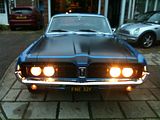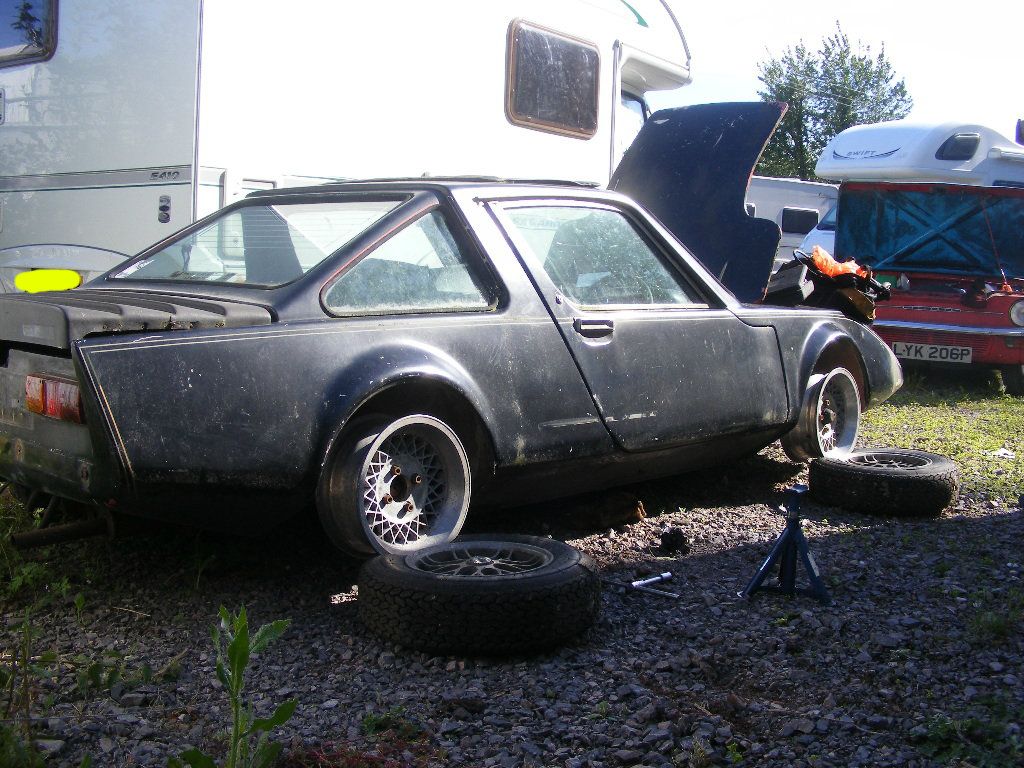ToolsnTrack
Posted a lot
   Homebrew Raconteur
Homebrew Raconteur
Posts: 4,129
Club RR Member Number: 134
Member is Online
|
SB Chevy V8 - TimingToolsnTrack
@overdrive
Club Retro Rides Member 134
|
|
|
How do chaps. Looking to gather as much info and tech as is humanly possible on this. I have had my engine in bits for months now, and i have to get her up and running again sharpish. Heres what i have done so far: * Its a 5.0 1982 Chevy on a rochester carb. I have a Holly 600 but for now i will leave the Rochester on as its a known quantity, and i need the lump to run with as few variables as possible. * Cam change for a Crane 284 deg cam. i did this fairly carefully with markers and such, so the new cam is in exactly the same timing as where the old one came out. Sitting on the bedding paste at the moment. * New Crane hydraulic lifters * Edelbrock Performer manifold fitted, with new gaskets. * New HEI distributor fitted. * New 10mm leads purchased. These will be fittted with new plugs. * New tubular exhaust fanimolds and system installed. Now, i could use some theory here. First off, what gap should i dial in to my rockers? Bearing in mind the lifters are hydraulic, i need to be sure i'm not going to bend a valve at higher RPM, especially with a bigger cam. Next up, what advance/retard should i be looking at? Or should i set TDC to zero to begin with and just play around from there? Cam bed in paste? Does this break down in the oil or should i be looking at an oil change shortly after a run in period? Ballpark figure? Also, i have been told the cam needs a 10 minute run at 2.5k RPM, now i may have issues with this due to the potential for leaks etc, is this imperative or just a guideline? If i cant get a 10 minute run, whats the worst that will happen? My biggest concern is that now there has been the alteration of so many components i may be chasing fault after fault here trying to get the lump to run. Of course, once all the discussion is in and i have a crack at it, i will document EVERYTHING as i go, and fire it up on this thread as a detailed guide for those who may follow in my steps. Till then, any advice is very much appreciated!  |
| |
|
|
|
|
|
|
|
Feb 14, 2012 10:24:36 GMT
|
|
beware of taking my advice, but...
hydraulic lifters are set zero lash. There is no gap. You may need adjustable valve train to maintain the correct geometry. Stock rockers rarely work with "healthy" cams for this very reason, unless custom length pushrods are used.
There are many theories about advancing a cam 3* to improve power or torque or whatever, but so long as the cam was installed correctly it will perform as the manufacturer intended. Did you use a degree wheel to install it? This is recommended practice.
Cam paste, break-in additives, particles of metal from the cam or new bearings, etc. will contaminate the oil and you are generally recommended to change the oil directly after break-in, and then at like 1500 miles.
I've always been told 20 minutes to break in the cam. I suspect its an inexact science. The idea is to throw some heat in to work harden the surfaces a bit and establish a proper wear pattern. If you don't do it there may be valve train failure in your future.
As I assume you are using a flat tappet cam rather than a roller you will need to either use a zinc additive* or a suitable old school oil rich in the zinc compound. Otherwise the cam / lifters will fail.
*zinc di-something toluene or somesuch. ZDT? ZZDT? Wasn't one of them the record label Frankie Goes to Hollywood was on?
|
| |
1941 Wolseley Not Rod - 1956 Humber Hawk - 1957 Daimler Conquest - 1966 Buick LeSabre - 1968 Plymouth Sport Fury - 1968 Ford Galaxie - 1969 Ford Country Squire - 1969 Mercury Marquis - 1970 Morris Minor - 1970 Buick Skylark - 1970 Ford Galaxie - 1971 Ford Galaxie - 1976 Continental Mark IV - 1976 Ford Capri - 1994 Ford Fiesta
|
|
|
|
|
Feb 14, 2012 10:36:45 GMT
|
As I assume you are using a flat tappet cam rather than a roller you will need to either use a zinc additive* or a suitable old school oil rich in the zinc compound. Otherwise the cam / lifters will fail. *zinc di-something toluene or somesuch. ZDT? ZZDT? Wasn't one of them the record label Frankie Goes to Hollywood was on? ZDDP is Zinc Dialkyl-Dithio-Phosphate. Being phased out of lots of oils now as it's not good for Catalytic converters. FWIW I'm using Millers Sport classic 20w50 |
| |
|
|
|
|
|
Feb 14, 2012 14:01:17 GMT
|
Akku's post contains much knowledge. I'd talk to Crane about the valve lash/lifter preload issues: they'll know best. I know that Ford smallblocks need some preload on the lifters (ie a little tighter than zero lash). Assuming that you mean igition timing, I'd set it to a few degrees (maybe 3?) before TDC for the initial run-up. Once the cam is bedded in and you start driving it you can dial it in more precisely. Bear in mind that the ideal setting will vary with the fuel that you use, so I'd tend to suggest sticking to one brand. I'd change the oil (and filter) after 50-100 miles (use running-in oil for this run), 500 miles, and 1000 miles using a reasonable quality mineral oil (maybe Morris Golden Film), then go to your choice of preimum oil and change every 6 months/6000 miles. I've also heard 20 minutes at 2500rpm for cam break-in. I'd suggest that if you have to stop for any reason (eg fluid leak) that you start again with another 20 minute run next time you start it. Camshaft running in: www.pumaracing.co.uk/cam1.htmI know exactly what you mean about chasing fault during the running-in period: I was doing exactly the same. However, as long as you do the cam break-in properly, and treat it right when you are driving it, you should be fine (assuming that it doesn't lose oil pressure or overheat). I followed a slightly different running-in procedure to most: it involves doing a run of 10 seconds at moderately high throttle positions around peak torque, and then letting it run gently for the next minute. This is repeated 10 times - the high cylidner pressured bed in the rings, but the short periods prevents any tight bearings from getting too hot. You then drive it gently to start with, building up to using most of the revs and throttle over the next ~100 miles. It seems to work quite well, but I don't have any evidence to prove it, other that the fairly low oil consumption of my engine. Engine running in: www.pumaracing.co.uk/runin.htm |
| |
|
|
|
|
|
Feb 14, 2012 21:42:05 GMT
|
|
V8's love a lot of advance. they are a big engine so it takes longer for the flame front to progress.
iv'e built race spec small block chevys so i do know a little bit
even with 10.5 to 1 compression you can run 36 degrees max advance.
hydraulic lifters are usually undo, just touch then one extra turn for preload. but it'll be best to check with the spec of the supplier (iv'e only done engines with solid lifters.
valvoline Racing 20/50 is all we ever use.
|
| |
|
|
ToolsnTrack
Posted a lot
   Homebrew Raconteur
Homebrew Raconteur
Posts: 4,129
Club RR Member Number: 134
Member is Online
|
SB Chevy V8 - TimingToolsnTrack
@overdrive
Club Retro Rides Member 134
|
|
|
|
Thats great gents, thanks for the pointers. Will let you know how it goes, and of course the much-loved first fire-up vids!!
|
| |
|
|
ToolsnTrack
Posted a lot
   Homebrew Raconteur
Homebrew Raconteur
Posts: 4,129
Club RR Member Number: 134
Member is Online
|
SB Chevy V8 - TimingToolsnTrack
@overdrive
Club Retro Rides Member 134
|
|
|
Jrevillug, just has a read of that Puma page. Very useful data in there, thanks. Clears a lot of the theory up! hydraulic lifters are usually undo, just touch then one extra turn for preload. but it'll be best to check with the spec of the supplier (iv'e only done engines with solid lifters. They are Crane "Max Intensity" lifters that provide higher lift with higher oil pressure. They are designed to work in conjuction with the 284 cam so i have been told, but i reckon zero lash will be the best bet just to play safe... |
| |
|
|
|
|
|
|
|
|
pretty much echo what has been already said . static timing I would use around 10 degree as a safe starting point at least for the cam bed in. also I would vary the rpm between 2k & 2.5k throughout the bedding in period also agree with the 20 mins as I also have a new Comp cams 305/305 cam to bed in on the escorts new 383ci chevy engine at the weekend so have been speaking with comp cams on this very subject . bedding in additive is very important though and the oil should be changed straight after
|
| |
Last Edit: Feb 15, 2012 7:34:35 GMT by Deleted
|
|
|
|
|
Feb 15, 2012 22:02:17 GMT
|
|
if i remember rightly anti pump up lifters run with only a few thou preload. are yours the bleed down version at low revs for better low end performance? it's just that you said about higher lift with higher oil pressure.
it is also common practice to fit light valve springs for the bedding in period then fit the heavy spring.
|
| |
|
|
|
|
|
Feb 19, 2012 20:44:49 GMT
|
pretty much follow what everyone else has put, 20 mins 2000-2500rpm as soon as it starts, do not let it idle if you have double valves springs, remove the inner comp cams do 2 run in substances, red thick liquid is used if running in the cam is going to happen pretty quick from installation, and a thick white stuff if the engine wont be started for a while i also ran my lifters over a piece of 1200 wet and dry and some light oil in a figure of eight, but i have a cleveland which love wiping cams fingers crossed nothing goes wrong  |
| |
|
|














